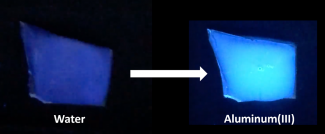Aluminum is a critical element used in thousands of important products, but it can often interfere with quick and effective extraction of valuable rare earth elements (REEs) from coal waste byproducts. Because aluminum interferes with the recovery of REEs from some sources, NETL researchers developed an effective, renewable, technology that can detect aluminum in liquids for removal, clearing the way for effective recovery of REEs.
REEs are a set of 17 metallic elements that are used in many high-tech devices. REEs are used in clean energy components like generators in wind turbines and electric vehicle motors in addition to defense systems, electronics and a large range of other consumer goods. Currently, most REEs are produced and refined in other countries. The creation of a reliable domestic supply of REEs is needed for U.S. economic, energy and national security.
The importance of the drive to secure more domestic REEs is reflected in investments in recovery technologies. Since January 2021, DOE has invested $25 million in 21 projects in Appalachia, the Gulf Coast, and other West and Midwest locations to support the production of REEs and critical minerals in traditional fossil fuel-producing communities across the country. DOE also recently announced up to $156 million in funding from the Bipartisan Infrastructure Law for a first-of-a-kind facility to extract and separate REEs and critical minerals from unconventional sources like mining waste.
The concentration of aluminum is often significantly higher than that of REEs in coal waste byproduct feeds, and the presence of aluminum can interfere with REE extraction and purification processes. Therefore, the detection of impurities such as aluminum is very important during REE processing. Impurities can be divided into two groups according to their value: low-value elements and high-value elements. Aluminum and iron represent typical low-value elements often associated with REEs in primary and secondary raw materials.
The new NETL-developed sensing material is a metal-organic framework thin film made of copper linked by 2-aminoterephthalic acid. The high-quality film can be grown within 30 minutes using a metal oxide template at room temperature, which eliminates the need for external heating or specialized equipment. The film emits blue light in the presence of water and becomes significantly more intense in the presence of aluminum ions.
As a proof-of-concept, the manufactured sensing films were tested on three fly ash leachates, and the fluorescence intensity correlated well with the aluminum concentration in the samples, highlighting the sensor's potential for real-world use. The same sensing film may also be recycled for multiple sensing cycles. Taken together, the NETL work presents a simple, scalable method for fabricating high-performance sensors to detect aluminum in solutions.
NETL researchers Scott Crawford, John Baltrus, Ki-Joong Kim, and Nathan Diemler developed the highly sensitive material that can be used to detect part-per-billion concentrations of aluminum.
In addition to detecting an impurity in REE feedstocks, removing and refining aluminum from liquid sources can also provide an additional domestic source of the raw material for the aluminum industry.
According to the U.S. Geological Service, “Aluminum is the second most abundant metallic element in the Earth's crust after silicon. It weighs about one-third as much as steel or copper; is malleable, ductile and easily machined and cast; and has excellent corrosion resistance and durability. Measured either in quantity or value, aluminum's use exceeds that of any other metal except iron, and it is important in virtually all segments of the world economy.
Some of the many uses for aluminum are in transportation (automobiles, airplanes, trucks, railcars, marine vessels), packaging (cans, foil), construction (windows, doors, siding), consumer durables (appliances, cooking utensils), electrical transmission lines, machinery and many other applications.”
NETL is a DOE national laboratory that drives innovation and delivers technological solutions for an environmentally sustainable and prosperous energy future. By leveraging its world-class talent and research facilities, NETL is ensuring affordable, abundant and reliable energy that drives a robust economy and national security, while developing technologies to manage carbon across the full life cycle, enabling environmental sustainability for all Americans.




